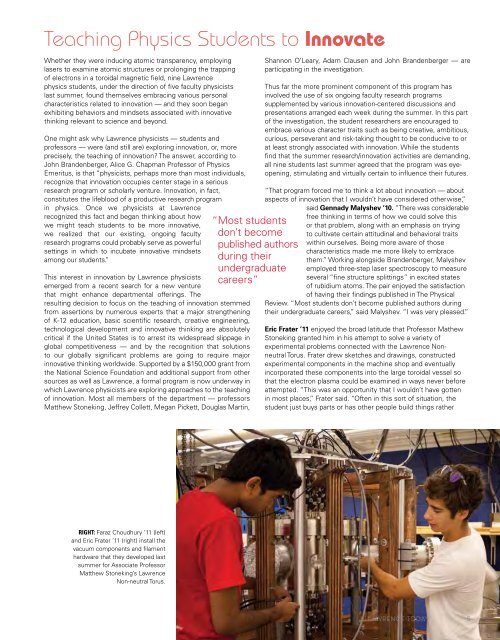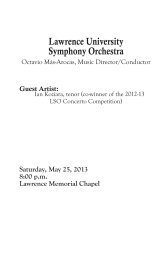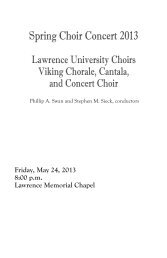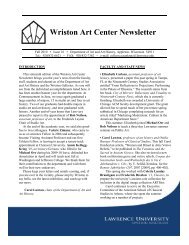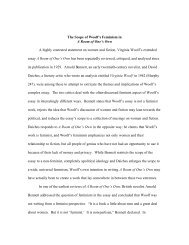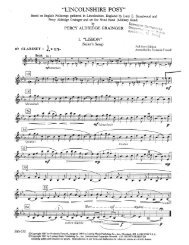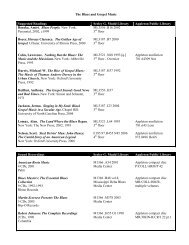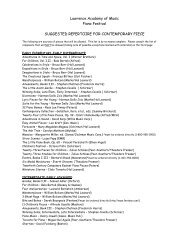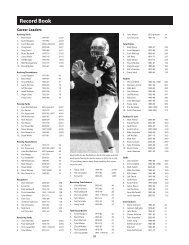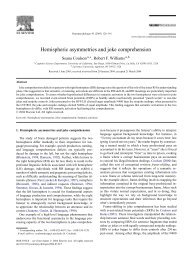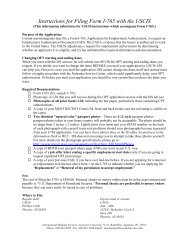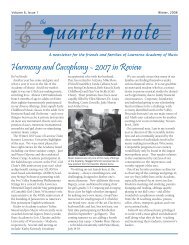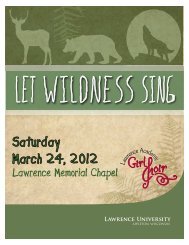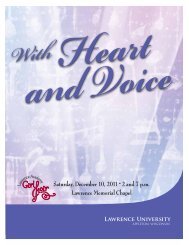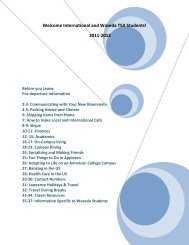Lawrence Today - Lawrence University
Lawrence Today - Lawrence University
Lawrence Today - Lawrence University
You also want an ePaper? Increase the reach of your titles
YUMPU automatically turns print PDFs into web optimized ePapers that Google loves.
Teaching Physics Students to Innovate<br />
Whether they were inducing atomic transparency, employing<br />
lasers to examine atomic structures or prolonging the trapping<br />
of electrons in a toroidal magnetic field, nine <strong>Lawrence</strong><br />
physics students, under the direction of five faculty physicists<br />
last summer, found themselves embracing various personal<br />
characteristics related to innovation — and they soon began<br />
exhibiting behaviors and mindsets associated with innovative<br />
thinking relevant to science and beyond.<br />
One might ask why <strong>Lawrence</strong> physicists — students and<br />
professors — were (and still are) exploring innovation, or, more<br />
precisely, the teaching of innovation? The answer, according to<br />
John Brandenberger, Alice G. Chapman Professor of Physics<br />
Emeritus, is that “physicists, perhaps more than most individuals,<br />
recognize that innovation occupies center stage in a serious<br />
research program or scholarly venture. Innovation, in fact,<br />
constitutes the lifeblood of a productive research program<br />
in physics. Once we physicists at <strong>Lawrence</strong><br />
recognized this fact and began thinking about how<br />
we might teach students to be more innovative,<br />
we realized that our existing, ongoing faculty<br />
research programs could probably serve as powerful<br />
settings in which to incubate innovative mindsets<br />
among our students.”<br />
This interest in innovation by <strong>Lawrence</strong> physicists<br />
emerged from a recent search for a new venture<br />
that might enhance departmental offerings. The<br />
resulting decision to focus on the teaching of innovation stemmed<br />
from assertions by numerous experts that a major strengthening<br />
of K-12 education, basic scientific research, creative engineering,<br />
technological development and innovative thinking are absolutely<br />
critical if the United States is to arrest its widespread slippage in<br />
global competitiveness — and by the recognition that solutions<br />
to our globally significant problems are going to require major<br />
innovative thinking worldwide. Supported by a $150,000 grant from<br />
the National Science Foundation and additional support from other<br />
sources as well as <strong>Lawrence</strong>, a formal program is now underway in<br />
which <strong>Lawrence</strong> physicists are exploring approaches to the teaching<br />
of innovation. Most all members of the department — professors<br />
Matthew Stoneking, Jeffrey Collett, Megan Pickett, Douglas Martin,<br />
right: Faraz Choudhury ’11 (left)<br />
and Eric Frater ’11 (right) install the<br />
vacuum components and filament<br />
hardware that they developed last<br />
summer for Associate Professor<br />
Matthew Stoneking’s <strong>Lawrence</strong><br />
Non-neutral Torus.<br />
“ Most students<br />
don’t become<br />
published authors<br />
during their<br />
undergraduate<br />
careers”<br />
Shannon O’Leary, Adam Clausen and John Brandenberger — are<br />
participating in the investigation.<br />
Thus far the more prominent component of this program has<br />
involved the use of six ongoing faculty research programs<br />
supplemented by various innovation-centered discussions and<br />
presentations arranged each week during the summer. In this part<br />
of the investigation, the student researchers are encouraged to<br />
embrace various character traits such as being creative, ambitious,<br />
curious, perseverant and risk-taking thought to be conducive to or<br />
at least strongly associated with innovation. While the students<br />
find that the summer research/innovation activities are demanding,<br />
all nine students last summer agreed that the program was eyeopening,<br />
stimulating and virtually certain to influence their futures.<br />
“That program forced me to think a lot about innovation — about<br />
aspects of innovation that I wouldn’t have considered otherwise,”<br />
said Gennady Malyshev ’10. “There was considerable<br />
free thinking in terms of how we could solve this<br />
or that problem, along with an emphasis on trying<br />
to cultivate certain attitudinal and behavioral traits<br />
within ourselves. Being more aware of those<br />
characteristics made me more likely to embrace<br />
them.” Working alongside Brandenberger, Malyshev<br />
employed three-step laser spectroscopy to measure<br />
several “fine structure splittings” in excited states<br />
of rubidium atoms. The pair enjoyed the satisfaction<br />
of having their findings published in The Physical<br />
Review. “Most students don’t become published authors during<br />
their undergraduate careers,” said Malyshev. “I was very pleased.”<br />
Eric Frater ’11 enjoyed the broad latitude that Professor Mathew<br />
Stoneking granted him in his attempt to solve a variety of<br />
experimental problems connected with the <strong>Lawrence</strong> Nonneutral<br />
Torus. Frater drew sketches and drawings, constructed<br />
experimental components in the machine shop and eventually<br />
incorporated these components into the large toroidal vessel so<br />
that the electron plasma could be examined in ways never before<br />
attempted. “This was an opportunity that I wouldn’t have gotten<br />
in most places,” Frater said. “Often in this sort of situation, the<br />
student just buys parts or has other people build things rather<br />
<strong>Lawrence</strong> <strong>Today</strong><br />
5


